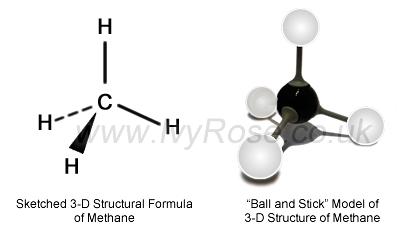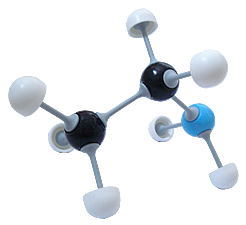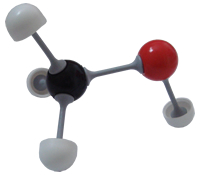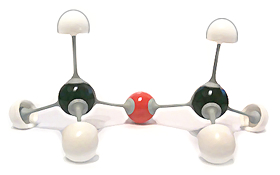
Structural Formulae of Organic Molecules
Drawing Organic Molecules (in general)
There are several standard ways to represent the structures of organic molecules in different levels of detail.
These include:
- Molecular Formulae of Organic Molecules
- Structural Formulae of Organic Molecules:
- Fully Displayed Formulae
- Simpler Displayed Formulae
- Sketched 3D Formulae
- Modelled 3D Formulae
- Skeletal Formulae
For more about drawing organic molecules generally see: How to Draw Organic Molecules.
Definition of a Structural Formula:
Unlike molecular formulae, structural formulae show how the atoms within organic molecules are joined together by various (single, double or triple) chemical bonds and in some cases how the atoms and bonds are arranged in 3-dimensional (3D) space.
Unlike molecular formulae, structural formulae show how the atoms within organic molecules are joined together by various (single, double or triple) chemical bonds and in some cases how the atoms and bonds are arranged in 3-dimensional (3D) space.
It is possible to draw the structural formula of an organic molecule in several different ways.
That is, there are different types of structural formulae which show different levels of detail and types of information, e.g. all the individual atoms (or not), all the individual bonds (or not), approx. bond-angles (or not), and representation in 2-dimensions or 3-dimensions.
The main types of structural formulae of organic molecules are:
- Fully Displayed Formulae
- Simplified Displayed Formulae (also called 'Semi-Displayed Formulae')
- 3D Structural Formulae (also called 'Sketched 3D Structures')
- Modelled 3D Formulae
- Skeletal Formulae
Descriptions and examples of each of these types of structural formulae of organic molecules follow below, together with links to more detailed information and further examples.
1. Displayed Formulae
Fully Displayed Formulae of organic molecules include every atom and every bond between atoms drawn in full so that it is possible to see which atoms are connected to which other atoms and by which type of covalent bond.
Examples of Fully Displayed Formulae
Propanoic Acid |
Hexanenitrile |
Propyl Pentanoate |
|
 |
 |
 |
Propanoic Acid
Hexanenitrile
Propyl Pentanoate
Use of fully displayed formulae is common and very helpful when first studying organic chemistry and working out organic molecular structures using rules about how many other atoms each type of atom connects to, which bonds can be double or triple bonds, and so on.
2. Simplified (Semi-Displayed) Formulae, e.g. incl. CH3
Fully displayed formulae can be simplified by grouping together the hydrogen atoms attached to each carbon atom in the chain(s), resulting in semi-displayed formulae, or simplified displayed formulae.
Depending on the level of 'simplification', single covalent bonds between adjacent carbon atoms in a chain or branch may, or may not, be shown.
Examples of Simplified Displayed Formulae
The examples of molecules shown below are the same as those represented by fully displayed formulae (above).
Propanoic Acid
Hexanenitrile
Propyl Pentanoate
Propanoic Acid |
Hexanenitrile |
Propyl Pentanoate |
|
3. 3D Structural Formulae (Sketched)
There is a standard system for representing the arrangement of atoms in organic molecules in 3-dimensions ('3D').
The symbols used are:
bonds that lie in the plane of the diagram (paper, or screen),
bonds oriented towards the viewer (so the approx. 'centre' of the molecule would be further from the viewer than the atom or functional group attached to it by a bond extending towards the viewer)
bonds oriented away from the viewer (so the approx. 'centre' of the molecule would be closer to the viewer than the atom or functional group attached to it by a bond extending away from the viewer).
The purpose of 3D Structural Formula is to convey more information than is included in a fully displayed formula by indicating approximate bond angles / orientations using these 3 styles of representation of bonds in 3D space.
Example of a sketched 3D formula of Methane (CH4)
Although it is useful to be able to draw 3D molecular structures of organic compounds, these diagrams can quickly become cumbersome and tricky to draw clearly. You are unlikely to have to draw 3D molecular structures of very complicated molecules for school chemistry tests. A common use of this type of representation of molecular structures is to explain isomerism, and optical isomerism in particular.
For more detail see: How to Draw Organic Molecules in 3D.
4. 3D Structural Formulae using Models, e.g. 'Ball and Stick'
Schools, colleges and universities have used 'ball and stick' models to teach and explain molecular structures in organic chemistry for many years. Molecular modelling kits are available for sale online or in many good bookshops, especially on university campuses. Computer software has also become available to enable students and scientists to to model molecular structures and rotate them in '3D space' on computer screens, interactive whiteboards, and similar.
Examples of 3D Models of Structural Formulae
Ethylamine (C2H7N)
Methanol (CH3OH)
Methoxy Methane (C2H6O)
Ethylamine |
Methanol |
Methoxy Methane |
|
|
|
|
|
|
|
See also 3D Models of Organic Molecules (to be added). |
||
5. Skeletal Formulae
Skeletal formulae are the least detailed structural diagrams of organic molecules.
The hydrogen atoms (attached directly to carbons) are not shown, resulting in the appearance of a 'carbon skeleton' with functional groups attached to it.
Examples of Skeletal Formulae
The molecules represented below are the same as those whose fully displayed formulae appear in Section (1.) and whose simplified displayed formulae appear in Section (2.).
Propanoic Acid
Hexanenitrile
Propyl Pentanoate
Propanoic Acid |
Hexanenitrile |
Propyl Pentanoate |
|
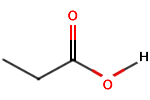 |
 |
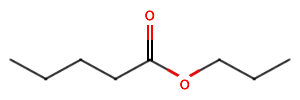 |
For more detail about understanding and creating these diagrams see: How to draw Skeletal Formulae of Organic Molecules.

